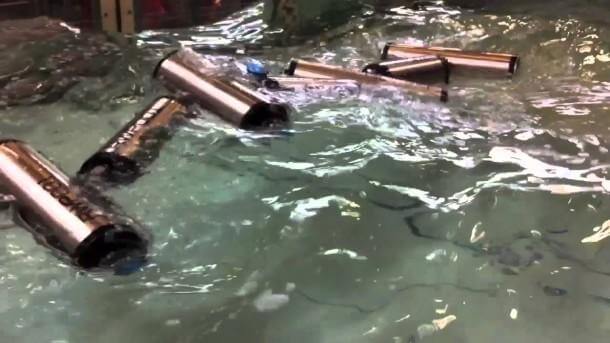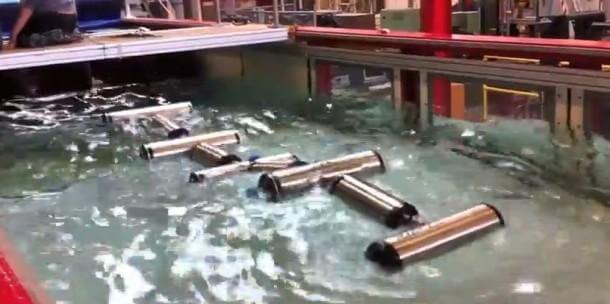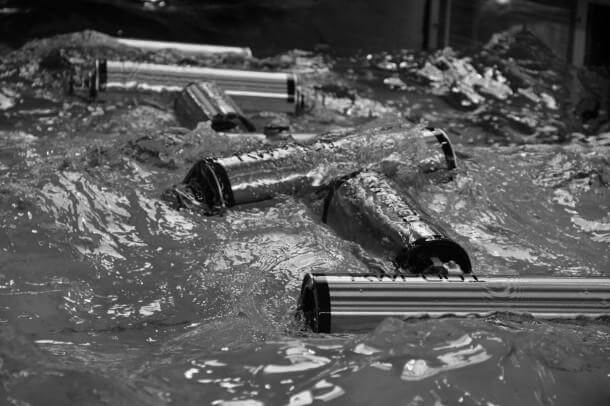 The UK national James Dyson Award was been won by Sam Etherington this year.
The UK national James Dyson Award was been won by Sam Etherington this year.
A multi-axis wave energy converter has been invented by Sam Etherington, a student of the Brunel University. This converter is more reliable and more efficient as compared to the present tidal power technologies as it is capable of absorbing forces from waves on any axis from any direction.
 While being interviewed by Wired.co.uk Etherington said, “Inspiration [for the project] came from a number of sources. Firstly, personal awareness that there simply must be alternative energy generation sources in the mainstream energy production industry if we are to avoid destroying the landscape that we live in. Secondly, kite surfing and sailing off the west coast of Cumbria has shown the sheer power within waves and the real potential for energy generation. Finally, diving trips in the Orkneys has put the world’s wave and tidal development technology at the European Marine Energy Centre firmly in mind.”
While being interviewed by Wired.co.uk Etherington said, “Inspiration [for the project] came from a number of sources. Firstly, personal awareness that there simply must be alternative energy generation sources in the mainstream energy production industry if we are to avoid destroying the landscape that we live in. Secondly, kite surfing and sailing off the west coast of Cumbria has shown the sheer power within waves and the real potential for energy generation. Finally, diving trips in the Orkneys has put the world’s wave and tidal development technology at the European Marine Energy Centre firmly in mind.”
The hydraulic pressure is built up by the cylinders covering Etherington’s wave converter working as pistons and riding the crests and troughs of the waves. This pressure is deposited into a motor coupled with a generator and it does not exceed a fixed limit.
The main task faced by Etherington was the sea itself as he told: “Oceans are some of the harshest environments to work in — it is therefore best to work with the forces than to repel them, if the product’s longevity is to be fulfilled. It can sometimes be very difficult to get people from industry to take me and the project seriously, as it is on such a large scale. However, funding from the James Dyson scholarship helped me to produce the 40th scale prototype and winning the award will help me take the project further still.”
Etherington further says while comparing the wave power to other renewable sources of energy that it is not “necessarily better than wind” but it is a “powerful and constant resource that the UK coastline has in abundance.” The prize money of £2,000 will be directly conducted into his test apparatus, says the design engineer finalist. He further said: “The structure itself only requires minimal investment for the sensors but the next area of further investigation is the hydraulic configuration. The efficiency of the hydraulics would be increased if they can be altered in real-time depending on the sea state and this is an area of potential development.”
The James Dayson Award strives for motivating young students to create innovative, thrilling ideas around science, design and engineering. The designers are dared to go after the brief “design something that solves a problem”.
 The judges of the award were Rhodri Marsden, technology writer for the independent; Sir Kenneth Grange, UK industrial designer; and Hawys Tomos, the British finalist of the 2011 James Dyson Award. Sir Kenneth Grange, the judge, said about the Etherington’s design that it “really stood out,” and “he uses wit and engineering to tackle a global problem with a global resource — wave energy”.
The judges of the award were Rhodri Marsden, technology writer for the independent; Sir Kenneth Grange, UK industrial designer; and Hawys Tomos, the British finalist of the 2011 James Dyson Award. Sir Kenneth Grange, the judge, said about the Etherington’s design that it “really stood out,” and “he uses wit and engineering to tackle a global problem with a global resource — wave energy”.
Seven runners-up were also chosen by the judges. Their designs consist of a low-cost personal outdoor fire alarm system, a 3D-printed artificial landmine for training deminers, a redesigned lifejacket and an amphibious prosthetic limb.



Hi
Kindly alert me, prior to next year’s WEC’s competition,
as I would like to present my optimum Wave Energy Converter, in terms of cost, performance, Vs. efficiency,
and enter the constructed scaled mechanical model (not prototype) to “The UK national James Dyson Award”.
Thanks
Haim D Cohen, B.Sc. Eng., M.I.C.E.